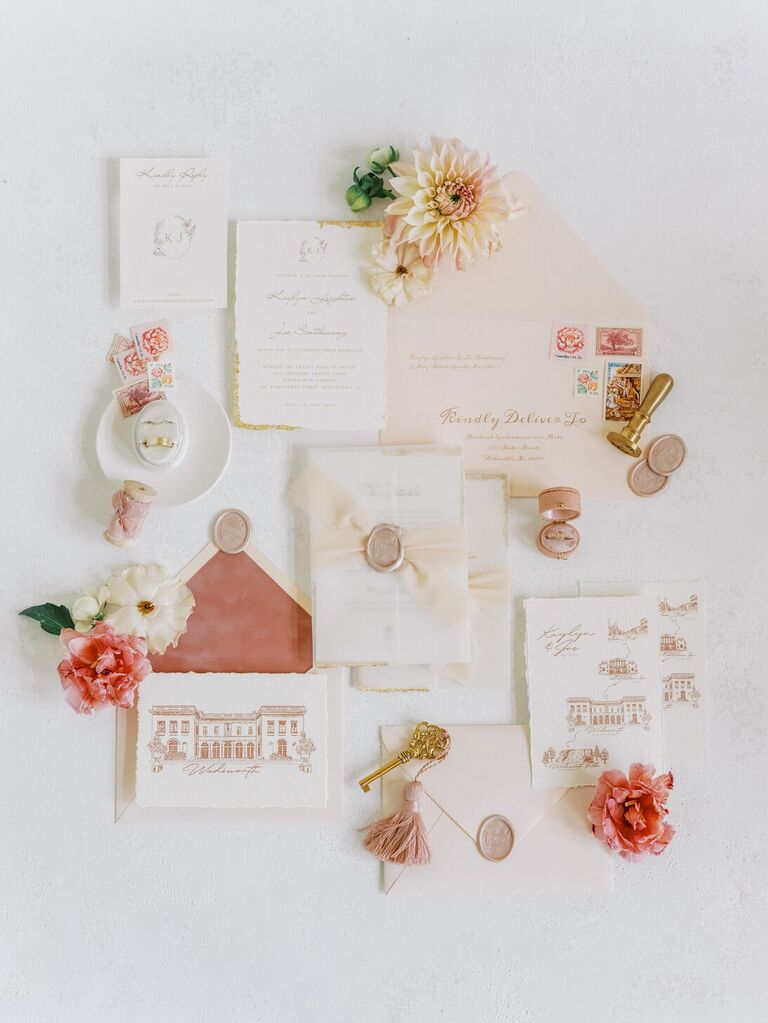How to Address Wedding Invitations the Right Way

So you've got the stationery of your dreams in hand and a fat stack of fancy envelopes sitting on your coffee table. The next thought running through your head: how to address wedding invitations. Properly addressing your invitations is the first step in making your guests feel welcome at your celebration. With that in mind, there are a few different scenarios you should be aware of that'll change how you write guests' names on your envelopes. For example, an invite addressed to a married couple differs from one addressed to an unmarried couple. To help you stay on top of the right envelope etiquette, we're sharing the most common examples of addressing an envelope below as well as answers to the questions we get all the time.
A few last pieces of advice: Give yourself enough time to collect mailing information from guests and get the address list in order so you can send your invitations out on time (and have enough of a buffer period to double-check any funky details and your wedding invitation wording before you hit the post office). Once you have all the info you need, head over to The Knot Invitations to check out our handy guest addressing service. Ready to get to the examples? Scroll down to learn how to properly address wedding invitation envelopes.
In this story:
- Where to Put an Address on an Envelope
- Addressing Wedding Invitations: Examples
- How to Include a Return Address on Wedding Invitations
- Addressing Wedding Invitations: FAQ
Where to Put an Address on an Envelope
If you're wondering if where to put the address on the envelope changes for a wedding invitation from a regular card, the answer is no. The invite's outer envelope should include the recipient's or recipients' full mailing address, placed in the center of its front side. If your invitation suite is elaborate, you may choose to have a stylish inner envelope that's protected during the mailing process by a more durable outer envelope. You do not need to write any address information other than the name of each recipient on the inner envelope when mailing wedding invitations.

Addressing Wedding Invitations: Examples
There are a few simple guidelines to follow when it comes to addressing a wedding invitation, whether it's a bid to a formal affair or to a backyard bash. Traditionally, there's a difference between inner and outer envelopes, and each follows their own etiquette rules. The outer envelope should be formal—our favorite option for this is to write out the recipient's or both recipients' full name(s), including their courtesy title(s). This format is foolproof, since it works for couples of all genders who may or may not share a surname, yet still feels somewhat traditional.
How do you address wedding invitations? Jump to examples of invitation address etiquette for a: Single Person | Family | Children 18+ | Married Couple | Unmarried Couple | Person With a Distinguished Title
Though, if you feel personal titles might feel restrictive and exclusive for some folks on your guest list (especially if some don't identify as Mrs., Ms., Miss or Mr.), feel free to forgo them in favor of this more modern way to address wedding invitations: just using first and last names. Also note that understanding the meaning of Mx., a gender-neutral personal title, might be helpful, as it could be how a non-binary guest identifies. Keep this info in mind, but always double-check every attendee's preferred personal titles beforehand as you hash out your wedding envelope addressing. By the way, this etiquette for addressing a wedding invite's outer envelope also applies to other correspondence related to your nuptials. If you're concerned, for example, about how to address wedding save-the-dates or how to address wedding announcements (for all you eloping lovebirds out there), the same methods go (especially since these stationery pieces don't have inner envelopes).
Inner envelopes are more informal, giving you the option to leave out one or two elements of the formal-name format of the outer envelope. Go with your gut here—if using personal titles and last names together feels right, that works. If you're going for casual vibes and would like to use first names only, you have our blessing.
How to Address a Wedding Invitation to a Single Person
Knowing how to address formal wedding invitations to single guests is the first step in mastering the art of addressing envelopes. First thing's first: You should always use the person's preferred title. If you're not sure, play it safe by forgoing a title altogether, as aforementioned in the previous section. For invitations addressed with a guest included, it's best to mention both people by name (if you have that info once you've determined who gets a plus-one). If you're not sure what name to include as the plus-one or you're allowing someone to bring a casual date, the words "and Guest" on the inner envelope will suffice.
Example One: Without a Plus-One
On the outer envelope:
Ms. Ali Johnson
On the inner envelope:
Ms. Johnson
Example Two: With a Plus-One
On the outer envelope:
Mx. Sam Li
On the inner envelope:
Sam Li and Guest
How to Address Wedding Invitations to a Family
For how to address an envelope to a family with a young child or children (under 18), the outer envelope is reserved for the name(s) of the parent(s) or guardian(s). You should list each child by name on the inner envelope. For girls under 18, you can use Miss, if you'd like. Boys don't need a title until they're 16—then they can be addressed as Mr.
Note: If you don't include each child's name, you're implying that children are not invited. That said, don't be surprised if some guests still mistakenly assume their kids are welcome. If you're concerned about some folks not taking the hint, ask your immediate family and wedding party to help spread the word that the wedding will be adults only, and also add the message to your wedding website. You may still have to give guests who didn't get the memo a call to kindly explain the situation.
Example:
On the outer envelope:
Mr. and Mrs. Abraham
On the inner envelope:
Mr. and Mrs. Abraham
Daniel, Jeffrey, Miss Brittany and Mx. Kelly
How to Address Wedding Invitations to Children 18+
If you're inviting a family that includes children who are 18 or older, they should each receive their own invitations (unless they're living at home with their parents, then you can follow the family format for how to address invitations in the last section). You don't need to use titles, but you can if you'd like. Just be sure that you're using the correct identifiers.
Example:
On the outer envelope:
Ms. Audrey Abraham
On the inner envelope:
Ms. Abraham

How to Address a Wedding Invitation to a Married Couple
If you're inviting a married couple, put their names on the same line. Other than that, there aren't too many binding rules these days. You're free to forgo titles and list their names separately (as shown below in example two). If they have different last names, list the person you're closest with first. If you're equally close with both of them, go in alphabetical order. Or, if one person has taken the other person's name, you can address the invitation to reflect that (shown below in example one).
And just a note: The classic "proper" process of how to formally address wedding invitations to married couples can feel pretty antiquated and sexist. It entails referring to the couple (if we're talking about a hetero couple) using just the husband's full name, leaving the wife's name off completely. We've listed it below for your reference, but are in favor of more modern formats of how to address a wedding invitation. These might include the full name of both partners or, simply, Mr. and Mrs. X if the pair shares a surname. Below, you'll see myriad ways of how to address a married couple on an envelope (including how to address a married couple with different last names)—and feel free to use different methods for different invited couples, depending on their ages and assumed preferences.
Example One: Same Last Name
On the outer envelope:
Mr. John and Mrs. Samamtha Rivera
Or
Mr. and Mrs. John Rivera
On the inner envelope:
Mr. and Mrs. Rivera
Or
John and Samantha
Example Two: Different Last Names
On the outer envelope:
Ms. Celine Elgin and Ms. Jacqueline Purcell
Or
Celine Elgin and Jacqueline Purcell
On the inner envelope:
Ms. Elgin and Ms. Purcell
Or
Celine and Jacqueline
How to Address a Wedding Invitation to an Unmarried Couple
If you're wondering how to address an invitation to an unmarried couple living together, it's a little different from the envelope format for a married couple. Both names should still be included on the envelopes, but in this case, each name gets its own line. Again, list the person you're closest with first or go by alphabetical order if you're equally close to both guests.
Example:
On the outer envelope:
Mr. Aaron Triguiero
Mr. Gabriel Reyes
On the inner envelope:
Mr. Triguiero
Mr. Reyes
How to Address Wedding Invitations to Those With Distinguished Titles
If a guest has a distinguished title (think: doctors, lawyers, judges or military personnel), it's proper etiquette to address them by that title on the wedding invitation envelope. Sending the invitation to a couple? List the guest with a professional title first or, if both guests have special titles of equal rank, you can list their names in alphabetical order. This is what to write on a wedding envelope when addressing these distinguished guests.
Learn the intricacies (there are many) of addressing military invitations.
Example One: Doctors
On the outer envelope:
Dr. Anne Barker and Mr. Peter Underwood
If the doctor uses their partner's surname socially:
Dr. Anne and Mr. Peter UnderwoodIf both parties are doctors:
Doctors Anne and Peter Underwood
On the inner envelope:
Dr. Barker and Mr. Underwood
Or
The Doctors Underwood
Example Two: Lawyers
On the outer envelope:
Michelle Brown, Esq. and Mr. John Brown
If both parties are attorneys:
Michelle Brown, Esq. and John Brown, Esq.
On the inner envelope:
Mr. and Mrs. Brown
Example Three: Judges
On the outer envelope:
The Honorable Gina Rodriguez and Mx. Alice Rodriguez
On the inner envelope:
Judge Rodriguez and Mx. Rodriguez
How to Include a Return Address on Wedding Invitations
We've answered your most burning question: "How do I address wedding invitations to my guests?" Now, we can shift the focus to you. Part of achieving the correct way to address an envelope for a wedding is to ensure your return address is right. It's not complicated, essentially the only rule you have to follow is to not use your married name (whether singular or hyphenated) without adding "the future" or "soon-to-be" or similar phrasing ahead of it. Just use your full names with or without courtesy titles and you'll be perfectly in line with wedding invitation address etiquette. Though, if your wedding is large and some guests might not be familiar with your (or your partner's) first name, it's best to include both in the return address.
Also, if you don't live together already, use the street address that you would prefer receiving your RSVP cards from guests at (this could even be a parent or family member's home). And lastly, you don't need your return address on the inner envelope, just in the upper-right-hand corner or on the back flap of the outer envelope.
Example One: Using Future Shared Last Name
The Future Mr. Jacob and Mrs. Kit Jakowski
Or
The Future Mr. and Mrs. Jakowski
Example Two: Separate Last Names
Ms. Margot Ronan and Mx. Jax Logan
Or
Margot Ronan and Jax Logan
Addressing Wedding Invitations: FAQ
Still unsure about the proper way to address your wedding invitations? We're answering your burning questions here, including how to order your guests' names and what to do if you're only using one envelope for assembling your invites.
How do you address wedding invitations with one envelope?
If you're only sending one envelope (an outer envelope) with your wedding invitations, all invited parties should be clearly stated on the front. This includes guests that are typically only listed on the inner envelope, such as plus-ones and kids. If you're short on space, you can replace children's individual names with the words "and Family" or simply opt for something like "The Abraham Family"—both are simpatico with wedding invitation addressing etiquette.
Do you have to address your wedding invites by hand?
Individually addressing your wedding invitations by hand is a nice touch, but it's not necessary. The process of how to address wedding envelopes is time-consuming on its own, so we totally understand if you want to print guest address labels at home or buy preprinted envelopes along with your stationery. Another way to neatly address wedding invitations without a fuss: hire a local calligrapher to do it for you.
Does The Knot Invitations offer envelope addressing?
If you're getting your wedding stationery from The Knot, you can absolutely take advantage of The Knot guest addressing service (it's free!) when you purchase your matching envelopes. Simply add a bunch of printed envelopes to your order, use our handy template to fill out your guest list information and send it back to the team. You'll get a digital proof of all the envelopes before they're printed, so you can double-check the information and make any necessary changes. Also, our free guest list tool lets you manage RSVPs and more once you finally get those addressed invites out. You're welcome in advance for saving you time and hand cramps.
How should you order guests' names on wedding invitation envelopes?
When it comes to the order of guests' names on a wedding invitation envelope, some couples choose to list the person they're closest with first followed by that person's partner, while others opt for alphabetical order. Ultimately, it's up to you if you want to follow one (or none) of these guidelines for whose name goes first on a wedding invitation. The only exception is when there are distinguished titles involved. In this case, the person with the higher-ranking title should be named first. Just remember: You definitely don't have to make any decisions about name order based on gender in today's society.
Where do you put guests' names on wedding invitations?
Based on standard wedding invitation wording, guests' names are not written on the actual invitations. You are only expected to address your loved ones by name on the outer and inner envelopes. That way, you don't need to print specific invites for every household you're sending them to.
How should I address separated or divorced women on wedding invitations?
How to address an envelope for a wedding to a woman who's divorced or separated would follow essentially the same guidelines for addressing an individual guest (addressing a widow is a bit different). If she's divorced and kept her married name, you can refer to her either as Ms. [Married Name] or Mrs. [Married Name] (we like the former, it feels more modern). If she reverted back to her maiden name, you can call her Ms. [Maiden Name]. If a woman is separated from her partner, you would traditionally still use "Mrs." since she's legally married, but you know your guests best. She might be more comfortable skipping the courtesy title and just being called by her full name.































